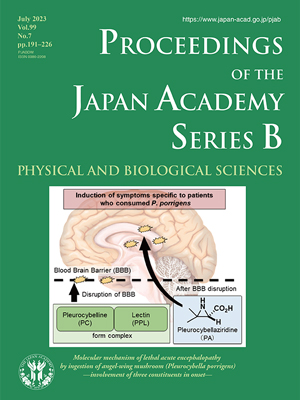About the Cover
Vol. 99 No. 7 (2023)
Sugihiratake (in Japanese, Pleurocybella porrigens, Angel-wing mushroom in English) is a mushroom widely distributed in the Northern Hemisphere, and it is traditionally enjoyed for its taste in the fall in many countries. However, the situation changed dramatically in the fall of 2004 following reports from Japan of acute encephalopathy caused by this mushroom. Seventeen people died among 59 patients, which was the worst food poisoning incident in Japan since World War II, and this was shocking in view of the absence of previous incidents. A task force was set by the Ministry of Health, Labour and Welfare in Japan, but 2 years of research were inconclusive, resulting in dissolution of the research team and the cause was left as “unknown”.
Dr. Kawagishi, the author of this review (pp. 191–197), however, continued addressing these unexplained cases. His courageous and admirable endeavor was motivated by two connections to the problem. Firstly, he was one of the task force members and secondly his enjoyment of eating this particular mushroom prior to 2004.
This study has now formulated a hypothesis of the “involvement of three constituents in onset”, in that brain damage was caused by the orchestration of three molecular entities: pleurocybelline (PC), Pleurocybella porrigens lectin (PPL), and pleurocybellaziridine (PA). Although PC exhibits lethal activity in mice and PPL is lethally toxic to rats, no brain abnormalities were attributed to PC and PPL in autopsied animals. Critically, PC and PPL form a complex that exhibits proteolytic activity, disrupting the blood-brain barrier (BBB). PA is then able to pass through the BBB, causing specific toxicity to brain cells, resulting in acute encephalopathy. Although PA was not isolated from the mushroom, a sample prepared by organic synthesis proved its endogeneity in the mushroom. Furthermore, PA exhibited toxicity to oligodendrocytes that were specifically damaged in the patients’ brains.
In conclusion, Dr. Kawagishi’s proposed theory of the “involvement of three constituents in onset” considers the specific combination of three compounds involved in increased levels of apoptotic cells in the brain. As an underlying molecular mechanism causing acute encephalopathy, the complex of PC and PPL destroys the BBB, then PA passes through the BBB and exhibits specific toxicity towards brain cells.
Keisuke Suzuki
Member of the Japan Academy




